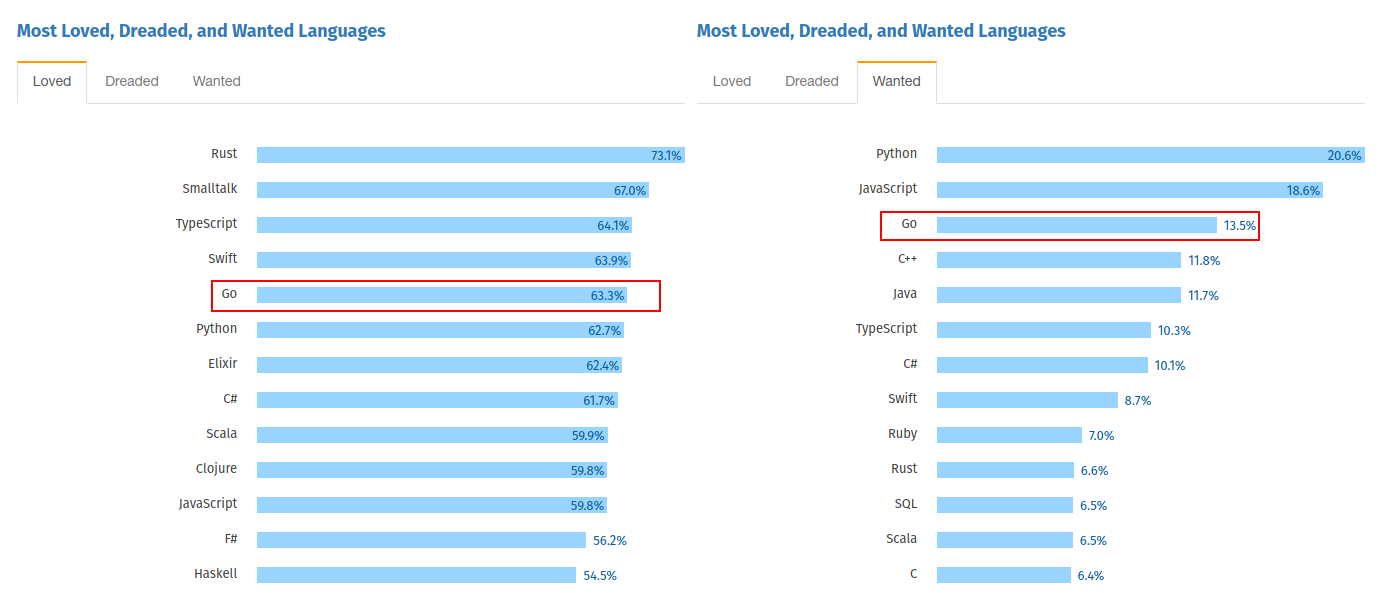Go for Science: Programming beyond Python¶
import "fmt"
n, err := fmt.Println("Hello, Gophers")
Hello, Gophers
Features¶
- Statically typed
- Compiled
- Quick and easy cross-compilation (Windows, Darwin, Linux, x86, ARM)
- Garbage collection
- Memory safe
- Built-in concurrency
- Fast compiler, fast runtime
- Interoperates with C code (cgo)
"Like C, but sane" Achilleas Koutsou, 2018
Why we think it's cool¶
- Open source!
- Fast growing (both community and ecosystem)
- Clean and small:
- Handful of keywords
- Automatic formatting
- Designed for concurrency
- Easy testing (for robust code)
- Statically compiled binaries
- Makes it very easy to distribute executables to various platforms
...
Why we think it's cool, part deux¶
- Automatic documentation generation and distribution:
- Function and package doc strings get automatically hosted on godoc.org
- Fast evolving but respects backwards compatibility
- The compiler is seriously super fast
- Easy and fun to learn:
- Go Tour quickly teaches everything you need to know to start working: https://tour.golang.org
- Online playground makes it easy to test snippets and share complete examples: https://play.golang.org
Most G-Node projects started after 2016 are written in Go: GIN, GIN Client, GIN DOI, GIN Indexing Service, and GIN Validator (if it's GIN, it's probably Go).

Other people like it too¶

Source: Stack Overflow developer survey, 2017 https://insights.stackoverflow.com/survey/2017#technology
Why you might think it's cool¶
- Fast and easy to learn (we went over this already)
- Good (fast) for number crunching while still feeling like scripting
- Concurrency for cluster analysis or multithreaded simulations
- Easy to write, statically link, and crosscompile for all platforms (e.g., experimental setups using Raspberry Pi)
- Scientific computing libraries with active dev communities
Example: Basic features¶
// C-like structs
type NewStruct struct {
Prompt string
Number int
}
// Can define methods on structs
func (ns NewStruct) ToString() string {
// C-like print directives and formatting
return fmt.Sprintf("%s: %d", ns.Prompt, ns.Number)
}
import "log"
// Type inference with :=
number := 10 * 42
news := NewStruct{"Number", number}
s := news.ToString()
// Explicit and localised error handling
n, err := fmt.Println(s)
if err != nil {
log.Fatal("Oh no! Print is broken")
}
Number: 420
Example: Concurrent simulations and analysis¶
Concurrency vs. parallelism¶
- Concurrency is about dealing with lots of things at once.
- Parallelism is about doing lots of things at once.
Not the same, but related.
Concurrency is about structure, parallelism is about execution.
Concurrency provides a way to structure a solution to solve a problem that may (but not necessarily) be parallelizable.
Taken from https://talks.golang.org/2012/waza.slide#8 "Concurrency is not Parallelism"

Taken from https://talks.golang.org/2012/waza.slide#19
import (
"fmt"
"math/rand"
)
func RunSim(name string, steps int) <-chan int {
spikechan := make(chan int)
go func() {
defer close(spikechan)
for t := 0; t < steps; t++ {
if rand.Float32() > 0.8 {
spikechan <- t
}
}
return
}()
return spikechan
}
reflect.Value.Convert: value of type func(reflect.Value) cannot be converted to type func(chan int)
func main() {
a := RunSim("A", 100)
b := RunSim("B", 100)
c := RunSim("C", 100)
for {
select {
case ta, ok := <-a:
if ok {
fmt.Printf("A spiked at %d\n", ta)
} else {
a = nil
}
case tb, ok := <-b:
if ok {
fmt.Printf("B spiked at %d\n", tb)
} else {
b = nil
}
case tc, ok := <-c:
if ok {
fmt.Printf("C spiked at %d\n", tc)
} else {
c = nil
}
}
if a == nil && b == nil && c == nil {
break
}
}
}
repl.go:3:10: undefined identifier: RunSim
Scientific libraries and projects¶
- GoNum: Numerical computing in Go (Go's numpy)
- GoNum/mat64: Linear algebra for float64 matrices
- GoNum/plot: For plotting and visualisation
- Machine learning libraries: go-cluster, go-deep, libsvm, neural-go
- GoBot: IoT and specialised hardware (check https://gobot.io/documentation/platforms/ for a ridiculously long list of platforms and devices)
- Jupyter kernel for Go notebooks (like this presentation)
Find everything you need at https://github.com/avelino/awesome-go
Questions & Comments welcome¶
You can find this presentation at https://gin.g-node.org/G-Node/Go-CNS-talk-2018